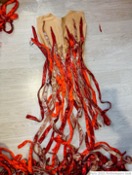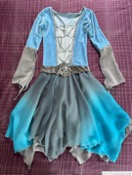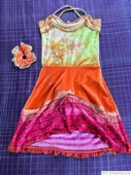YOU GRADUATED AS A FASHION DESIGNER IN PARIS. WHAT BROUGHT YOU TO MILAN?
After studying styling in Paris, I worked for about a year as a salesperson at the Galeries Lafayette. This gave me a new perspective on fashion: it is not just about the creative process or the related techniques, it’s about reaching customers too. Every day was a new challenge aiming to achieve the highest turnover possible. That’s a great experience. This is what made me realise that I was keen to know more about fashion, but this time from an industrial standpoint. This is why I came to Milan, where I applied for a Master in Fashion Business.

YOU HAVE BEEN QUITE ACTIVE ON VARIOUS FIELDS HERE IN MILAN. WE’VE SEEN YOU DANCING, CREATING CLOTHES FOR SHOOTINGS, MODELLING, AND COLLABORATING WITH FASHION BRANDS.
This is what I like so much about fashion: one can live it as a complete experience. For me fashion is a lifestyle. Drawing a sketch, sewing clothes, creating makeup, dancing on a stage… I don’t see all these activities as separate ones, but as a continuum where the endgame is to be the best version of myself.

IS IT THE SAME ENERGY THAT PUSHED YOU TO COMPETE AS A SYNCHRONISED ICE-SKATER, WHERE YOU WON THE FRENCH CHAMPIONSHIP TWICE?
That was some years ago, and it’s a team sport, so you win as a group, not as individual. Like every sport, it requires a lot of discipline and practice. I remember hours and hours repeating the same movements to reach a perfectly well executed choreography.
CHOREOGRAPHY, MAKEUP, COSTUMES… WOULD YOU SAY THAT YOUR CURRENT ACTIVITIES ARE DEEP ROOTED IN YOUR ICE-SKATING BACKGROUND?
I was not creating the choreography, nor the makeup or the costumes, but yes, I guess there are some links there. And I think this is where my interest sparked.
ICE-SKATERS COSTUMES CAN BE QUITE KITSCH…
Of course, they can be seen as kitsch, but they serve a purpose. When you compete, you are on ice for 3 minutes and 30 seconds. This is the only time you have to impress a jury sitting meters away from you. There is no time for being subtle. You need to make a point not just with your skating techniques, but also with your costume and your makeup. They need to be immediately understandable and coherent with your program.
WHAT ABOUT NOW? HOW DO YOU INCORPORATE YOUR BACKGROUND AS AN ICE-SKATER WITHIN YOUR DAILY LIFE?
Discipline, determination, and passion. I remember waking up at 4 am, be at the ice ring at 7 am, then go to school and even though it was hard, I pushed myself through. I've been keeping that same energy of work ethics ever since. Also, style-wise, with a look we had to convey a story, and now through the looks I create and wear I put the focus on the meaning behind it so that it’ll be more impactful.

SPEAKING ABOUT STYLE, HOW WOULD YOU DESCRIBE YOURS?
In rap music, what makes an artist unique is their flow. When I design some clothing, I care about it. I like clothes to have a structured, dynamic flow and, likewise, to be a sort of statement for the person wearing it: something like “I am confident, I am powerful, but I am cool”. Thanks to dancing, I always remember that clothes must be comfortable and move nicely with you.

RECENTLY YOU DESIGNED A CONE-BRA REFERRING TO JEAN PAUL GAULTIER ICONIC CREATION. IS HE ONE OF YOUR INFLUENCES?
Yes, I truly admire his work. In the 80s he brought to the catwalk a gender fluid approach that was ahead of his time, for instance when he created skirts for men. He was one of the first to have non-conventional models on the runway too. Later on, he brought a modern touch to Hermès while playingwith the brand’s traditional trademarks. More generally, I like creators who are innovative, breaking new grounds. When Chanel appointed Karl Lagerfeld, it was a dusty brand, today it is one of the most successful in the world. And yet Chanel didn’t renounce to any of its trademarks, but Lagerfeld used them as a fertile ground. The same goes with Olivier Rousteing and Balmain or, before that, with John Galliano and Dior

by DARE CLAN




Comments